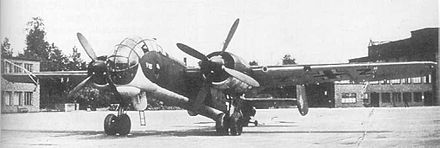I don't have much prepared for the Easter days' release, so I'll simply drop a few hints to fascinating old aircraft types that never really made it to production. (This post was in the draft stage since 2013, so this is really a kind of emergency filler for the blog.)
Historic aircraft are an old hobby of mine. People with a similar interest should have a look at the secretprojects.co.uk forum.
 |
| Horten Ho X |
Here's an artist's impression of a Horten Ho X. This could have been a fighter of the 1947 generation with the second German generation of turbojets (HeS 011 engine, 13 kN). Turbojets coupled with such a large wing area would have yielded a superb performance at high and extremely high altitude (if cabin was properly pressurised), but the fighter would have been quite useless at low altitude and still inefficient at medium altitude (fuel consumption was tripled at low altitude). The project didn't advance much and it's questionable if the small developing company would have been able to stem the development in a few years. Maybe some other company could have taken over the detail development as happened with Ho IX/Gotha P.60.
 |
| XB-28 |
Next, a North American XB-28 Dragon prototype, I rate it as one of the very best bombers of its period. The USAF was pig-headed and insisted on thinking of it as a medium bomber despite having heavy bomber performance. Its high altitude performance was not needed for medium altitude. Cheaper medium bombers of significantly lesser flight performance (B-25 and B-26) were available for bombing at medium altitudes, thus no B-28 quantity production orders were given. The B-28 would have been a most famous WW2 aircraft today if it had been employed as a strategic bomber to replace B-17s in combination with RAZON munitions in '44.
 |
| Ju 288V-13, prototype for C version |
Junkers Ju 288. It's similar to the XB-28 with pressurised cabin and remotely operated armament, but with greater speed and bombload. Intercepting this bomber would have been difficult, pursuit would have been quite pointless - and this in addition to it having good range, normal armour protection, self-sealing fuel tanks and defensive guns.
It was overall a much better design than the XB-28 (quite a feat!), but Germany didn't get remote control of defensive guns as right throughout WW2 (despite employment in Me 210/410 and some He 177) as did the Americans. This bomber was tied to an exceptional aircraft engine (Jumo 222), and it's never been completely understood why this engine never left development stage. It may have been a mix of political intervention, mission creep and use of scarce metal alloys. The Ju 288 design had mission creep as well, with the B version being a larger redesign of the A version and C version being meant for some vastly inferior engines. The relatively ordinary DB 603 engine had reached enough power (1,900 hp) and reliability to propel the Ju 288A version by 1944, but by then there was no interest in a new piston engine bomber any more.
 |
| Hs 127 V-1 |
 |
| Hs 127 three-view line drawing |
This is the Henschel Hs 127. It looks like a de Havilland Mosquito, right? It flew in 1937 and was meant to be faster than any fighter at that time (actually as fast as the fastest in-service fighters in 1940). Its bad luck was that it competed against the excellent Junkers Ju 88 while being the more tactically daring and unusual concept. Later in WW2, the Mosquito proved the soundness of the Hs 127's concept in many roles including night fighter. I do not quite understand why the Hs 127 design (which did reach the prototype stage) is never being mentioned when the issue of aircraft types available to Germany as night fighters in 1940-1945 comes up.
S O
.

The Horton looks to have a low radar cross section. I wonder if that was by design? Or just an unplanned bonus from her aerodynamic streamlining?
ReplyDeleteAs (more or less) part of the Emergency Fighter Program (Jägernotprogramm), the Ho X's fuselage and wings would have been constructed mainly from plywood, so Radar problems would be similar to the Mosquito from production alone. Apart from that, there might be some small positive issues from the small frontal signature (see Nothrop YB-35). From what I've read everything about RCS reduction seems to be pure speculation/made up in the 1980s and 1990s.
Delete